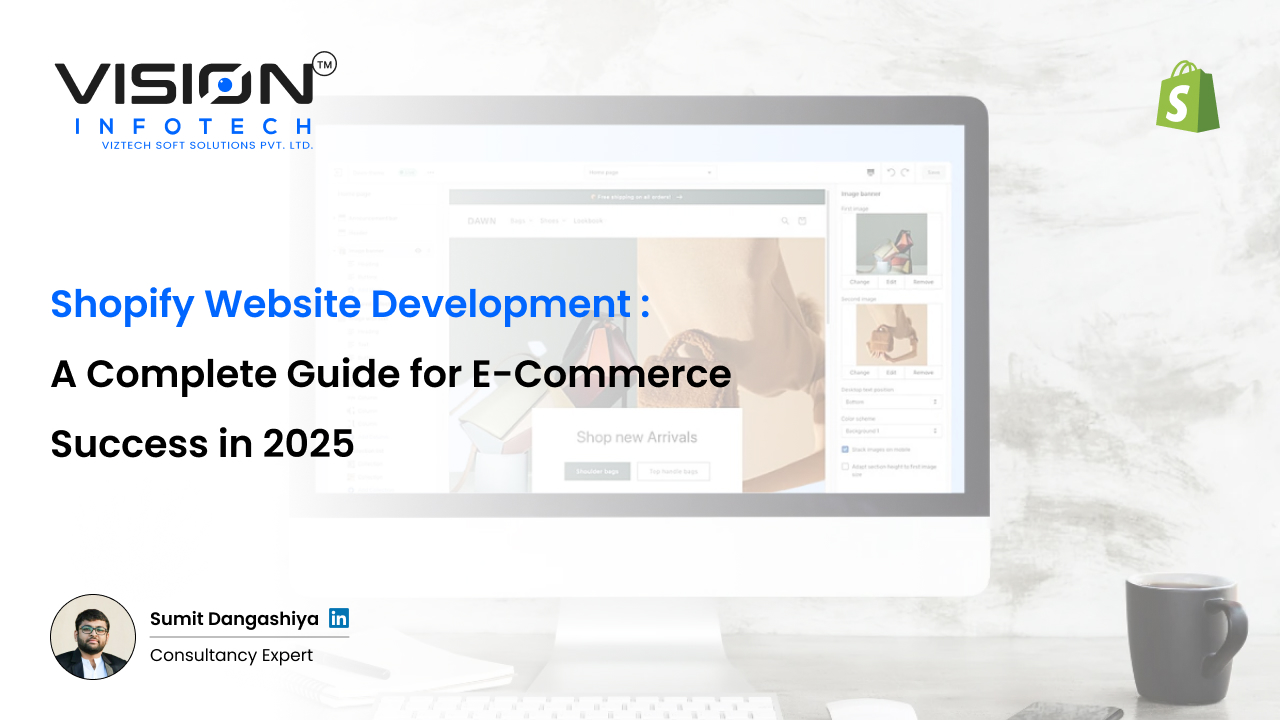Blog
Our blog offers a window into the world of Vision Infotech, where we share expert advice, industry trends, and success stories. Stay informed and inspired with our latest posts.

Shopify Website Development: A Complete Guide for E-Commerce Success in 2025

Sumit Dangasiya
January 13, 2025In today’s fast-paced digital world, e-commerce has become a vital component for business growth. Shopify, as one of the most powerful and popular platforms, allows businesses to set up, manage, and scale online stores with ease. If you’re considering Shopify website development in 2025, this comprehensive guide will walk you through the process of building a successful e-commerce store and highlight the key steps you need to take to ensure long-term success.
1. Why Choose Shopify for Your Online Store?
Shopify is a robust, user-friendly platform designed to cater to businesses of all sizes. Whether you are a small startup or an established enterprise, Shopify’s versatility makes it the ideal choice for your online store. It offers a variety of customizable templates, an intuitive interface, and powerful tools for managing inventory, orders, and customers.
One of the key reasons to choose Shopify is its ease of use. The platform is built to be user-friendly, meaning you don’t need to be a tech expert to set up your store. Additionally, Shopify’s scalability means you can start with a basic setup and grow your store as your business expands.
2. Setting Up Your Shopify Store
When it comes to Shopify website development, the first step is setting up your store. The process is straightforward and can be completed in a few simple steps.
Create an Account: Start by signing up for Shopify. You’ll need to provide your business details, including your name, address, and payment information.
Choose a Theme: Shopify offers a range of free and paid themes that you can choose from. Pick one that aligns with your brand and provides the right layout and features for your store.
Customize Your Theme: After selecting your theme, you can customize it to suit your preferences. Shopify’s drag-and-drop interface makes it easy to modify the design elements, including colors, fonts, and logos.
Add Products: Once your store design is set, you can begin adding products. For each product, include images, descriptions, prices, and shipping details. Shopify also allows you to organize your products into collections, making it easier for customers to navigate your store.
3. Mobile Optimization
In 2025, a significant portion of e-commerce sales will be made through mobile devices. As a result, mobile optimization is critical for ensuring your online store performs well on smartphones and tablets. Fortunately, Shopify’s themes are responsive, meaning they automatically adjust to different screen sizes.
To further enhance the mobile shopping experience, ensure your product images are optimized for fast loading times, and streamline your checkout process to reduce cart abandonment.
4. Payment Gateways and Security
Choosing the right payment gateways is essential for ensuring secure transactions on your Shopify store. Shopify supports a wide range of payment options, including major credit cards, PayPal, and Shopify Payments.
It’s important to integrate secure payment systems to protect both your business and your customers. Shopify complies with Payment Card Industry Data Security Standard (PCI DSS) regulations, so you can trust that your store is safe for transactions.
Additionally, don’t forget to enable SSL certificates on your store. These certificates encrypt customer data, ensuring that sensitive information such as credit card details is securely transmitted.
5. Setting Up Shipping and Taxes
Shipping and taxes can be complex for e-commerce businesses, especially when selling internationally. Shopify makes it easier by allowing you to set up shipping zones and rates based on your location and the countries you ship to. You can also integrate third-party shipping carriers like USPS, FedEx, or UPS for real-time shipping calculations.
Similarly, Shopify allows you to configure taxes according to the regions where you operate. You can set tax rates for specific countries, states, or provinces, ensuring that your customers are charged correctly during checkout.
6. SEO Optimization for Shopify Stores
Search Engine Optimization (SEO) plays a critical role in driving organic traffic to your Shopify store. By optimizing your store’s content, you can increase your visibility on search engines like Google, which will help attract more visitors to your store.
Here are some basic SEO tips for Shopify:
Use descriptive and keyword-rich product titles and descriptions.
Optimize your image alt text to help search engines understand your images.
Create SEO-friendly URLs that are short and contain relevant keywords.
Use Shopify’s built-in blogging feature to create regular, SEO-optimized blog posts that provide value to your customers and improve search rankings.
7. Marketing Your Shopify Store
Marketing is crucial to the success of any online business. Shopify provides several built-in marketing tools to help you promote your products and attract customers.
Email Marketing: Use Shopify’s email marketing feature to send newsletters, promotions, and product updates to your customers. Personalized emails can help build customer loyalty and drive repeat purchases.
Social Media Integration: Shopify allows you to integrate your store with popular social media platforms like Instagram, Facebook, and Pinterest. You can create shoppable posts and ads directly from Shopify, enabling you to sell on social platforms.
Discounts and Coupons: Offering discounts is an effective way to attract new customers and increase sales. Shopify lets you create various discount codes, including percentage-based discounts, free shipping, or fixed amount off.
8. Managing Customer Relationships
One of the most valuable assets for any online store is its customer base. Shopify’s customer management tools help you track customer interactions, build personalized marketing strategies, and provide excellent customer support.
Customer Accounts: Allowing customers to create accounts on your store can help you track their order history, preferences, and personal details for easier shopping experiences.
Customer Service Integration: Shopify integrates with third-party apps like Zendesk and LiveChat, making it easy to manage customer inquiries and provide support.
9. Analyzing Store Performance
To improve your store’s performance, it’s essential to track and analyze data. Shopify provides powerful analytics and reporting tools that allow you to monitor key metrics such as sales, traffic, and conversion rates.
Google Analytics Integration: Shopify integrates with Google Analytics, enabling you to track detailed visitor behavior, sources of traffic, and more.
Shopify Reports: Shopify’s built-in reports offer insights into your store’s financial performance, including sales trends, product performance, and customer demographics.
10. Future-Proofing Your Shopify Store
In 2025, the e-commerce landscape will continue to evolve. To ensure your Shopify store remains competitive, it’s essential to keep up with new trends and technologies.
AI Integration: Artificial intelligence (AI) is becoming increasingly important in e-commerce. Tools like AI-powered chatbots and product recommendation engines can help enhance the customer experience.
Voice Commerce: With the rise of voice assistants like Alexa and Google Assistant, voice commerce will play a significant role in the future. Shopify is already integrating voice search capabilities to make it easier for customers to shop using voice commands.
Conclusion
Shopify Website Development is an excellent platform for building and managing a successful e-commerce store in 2025. By following the steps outlined in this guide, you can create a well-optimized, secure, and profitable online store. Remember, the key to long-term success is not only about building a functional website but also about consistently optimizing, marketing, and evolving your store to meet the demands of the modern e-commerce world.
By choosing Shopify, you’ll have a powerful foundation to launch your business and scale it efficiently as you grow. Whether you’re just starting or looking to optimize your existing online store, Shopify provides everything you need to succeed in the competitive world of e-commerce.
Read Also :- WordPress Websites for E-Commerce in 2025: Build Your Online Store Today
Schedule your FREE session today!
Book your FREE Consultation Meeting with a Vision Consulting expert.
Table of contents
Get In Touch With Us
Join Our Team
Your Benefits :
- Client Oriented
- Competent
- Transparent
- Independent
- Result - Driven
- Problem Solving
What Happens Next?
- We Schedule a Call at Your Convenience.
- We Do a Discovery and Consulting Metting.
- We Prepare a Proposal.
Industries
Services
Hire Developer
Technology

